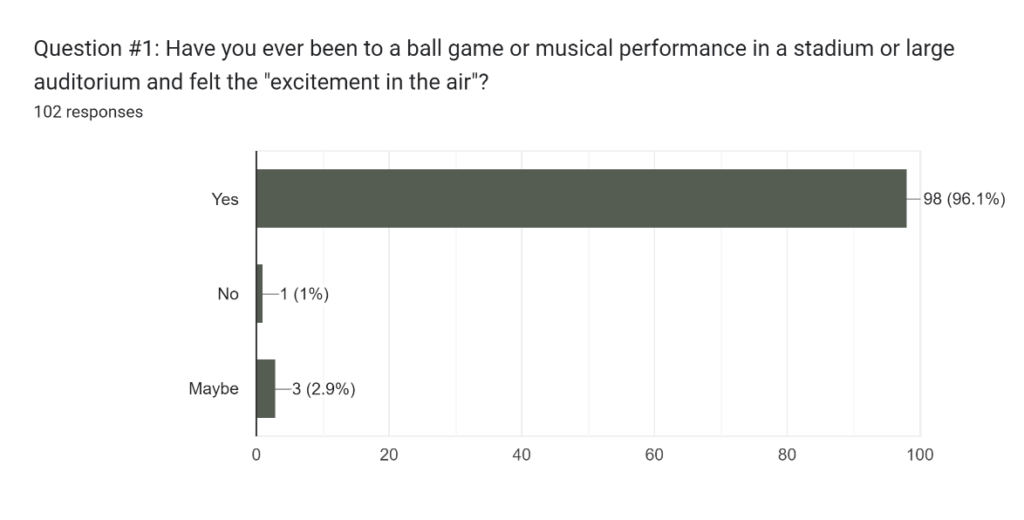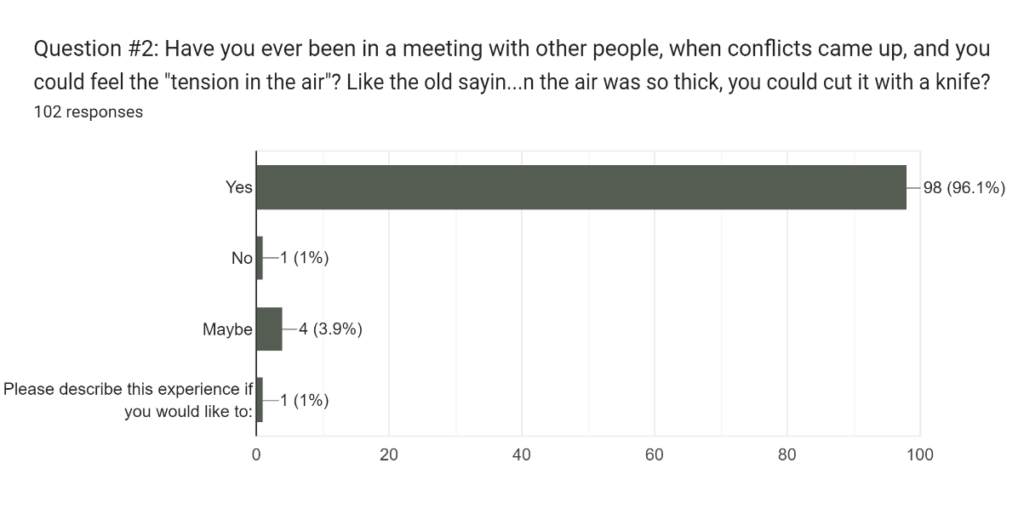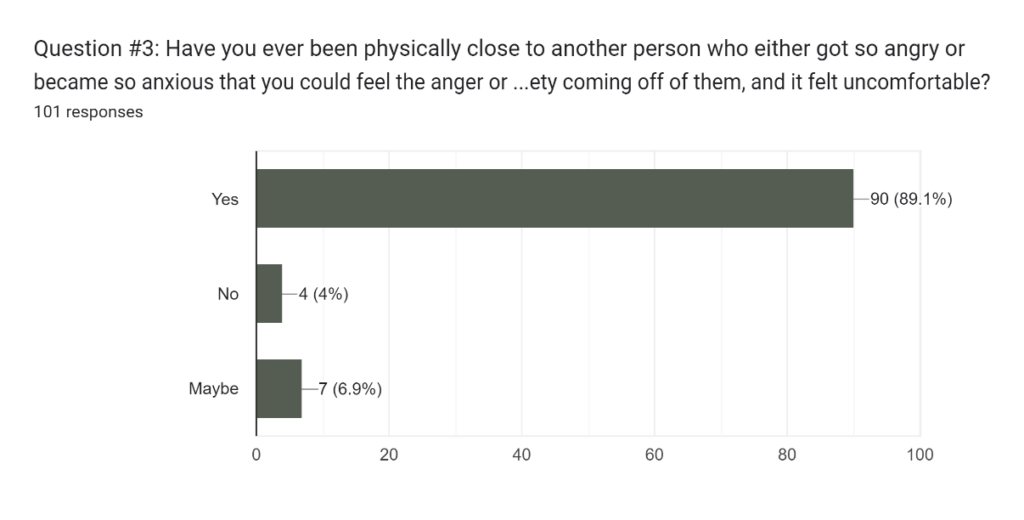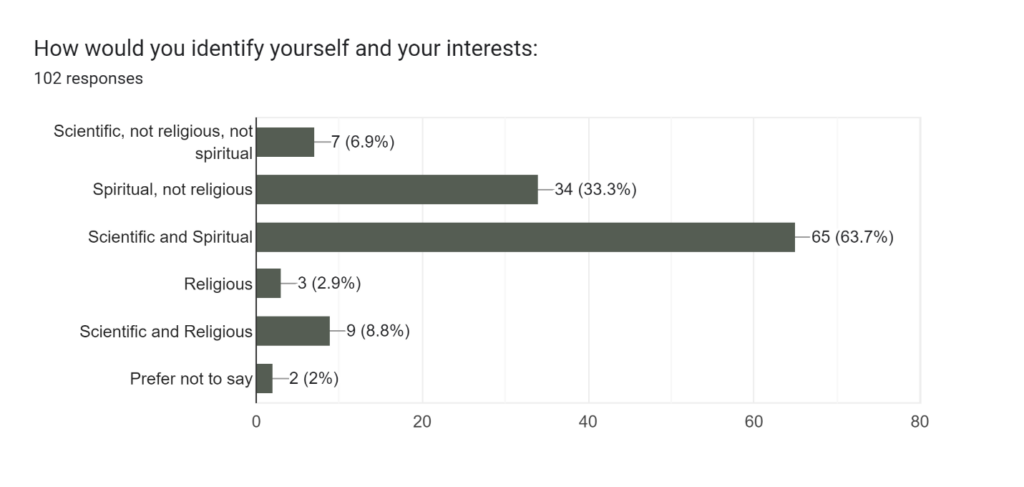Emotions in the Air
One of the traditional English phrases for the subtle energy of emotions is still popular: “the excitement in the air.” Many people use this phrase when referring to how it feels to attend a sporting event or a large musical concert, yet we don’t usually analyze what that “excitement in the air” actually consists of, or whether it is a real construct, and not “just” a subjective experience.
Another traditional English phrase for the subtle energy of emotions in the air is the old saying: “The tension in the air was so thick, you could cut it with a knife!” We seem to take these phrases for granted, yet they keep getting passed on from generation to generation.
As part of her PhD dissertation, Carol Richardson, a PhD candidate at the California Institute of Integral Studies, decided to research these subtle energies of emotions, to see whether or not most people feel them. For over ten years, as an energy healer, Reiki Master, and meditation teacher, Richardson has been sharing these phrases with people to help them understand the nature of spiritual energies, including healing energy. What she has found in these informal settings has been that only people who are too young to have had such experiences, or males who have been taught to shut down their own emotions, or people who were deprived of unconditional love as children seemed to be unable to feel such shared emotions.
Researching Human Awareness of Subtle Energies
What happens when people are at a ballgame and feel the excitement in the air? How do we explain that phenomenon? Is it a real phenomenon? With 102 subjects having already responded to Richardson’s online survey: “Human Subtle Energy Awareness,” the results are clear that people do experience other people’s emotional energies “in the air.”




As we can see from the data above, a clear majority of respondents have answered ‘yes’ to all four questions about feeling the energy of other people’s emotions. While a full statistical and theoretical analysis has not yet been performed, these results suggest that there is a very real phenomenon occurring here. The interpretation of that phenomenon could, of course, be viewed from a variety of perspectives.
Indeed, given an opportunity to describe both their experiences, and their sense of self along with their worldview, subjects expressed a variety of understandings. To make sense of their experiences and their worldviews, their answers to the given categories for sense of self and worldview must first be noted:

The total percentages are a little off, because 18 out of the 102 respondents chose two answers. What is important to note here is that the total respondents who identified as “scientific” with or without adding either “spiritual” or “religious” was 79.4%. Thus, most respondents value a scientific worldview. In addition, in this population, most respondents – 72.5% – value a spiritual or religious view as well as a scientific view.
In this context of worldviews, many subjects responded that they were very sensitive to other people’s energies. Several reported that they are empaths or empathic and they have to protect themselves from other people’s negative energies like anger and anxiety. Several respondents gave descriptions of experiences of human subtle energies that really stood out to them.
Two subjects who described themselves as “Scientific, not religious, not spiritual,” did express objections that can enable us to examine what people are really experiencing more clearly. In one case, the respondent stated, “I don’t [want to describe any of the experiences], but frankly these questions are pretty leading! Most people will of course say ‘yes’ or ‘maybe’ to all questions unless they are an emotional brick, but that doesn’t give you any insight as to whether these are purely subjective experiences or if there really exists an emotional energy field that we are perceiving.”
Clearly, this person has some expectation that people will feel emotions but offers the terminology “subjective experience” as an explanation. We might respond by asking: does Western science really have a thorough, multidisciplinary, and integral explanation of what it means to “feel” emotions? Or is some component of emotional “energy” beyond the materialistic scientific paradigm necessary to explain such a feeling? Can Western science adequately explain a transpersonal experience?
We can also ask: does Western science thoroughly explain what it means to have a “subjective experience”? Is that just a set of thoughts in a person’s brain, or also a feeling state in the person’s body? If it is an experience the individual is having within themselves, is it really isolated from other people, as is suggested by claiming it is a “purely subjective experience”?
When we look at the numerous answers given by other respondents, we can see a clear pattern that these experiences, whether “subjective,” or even partly internal to the individual, also clearly involve a transpersonal connection in the sense of experiencing energy from other people. Here are just a few of the many experiences described by respondents that suggest a transpersonal experience of emotional energy extending beyond individuals and among groups of people:
“I am an empathic person and I feel intensely. For each of the above scenarios. There is an instant ‘knowing’.”
“Yes, all the time as I am empathic 🙂 I also get chills when I or someone else speaks a truth”.”
“I can pretty instantly pick up on the energy of the person next to me. If I had to rank the experiences, I would say I pick up on anxiety most often, tension & excitement semi frequently and more so in groups, anger is an easy read, and love is less common but just as powerful.”
“I usually can sense how others are feeling. It is a gift and curse at the same time. I am not sure how to describe it, but I feel the energy of others easily and all the time.”
“I think there are too many experiences like this to fully describe, but I can feel their emotions energetically entering into me / my aura, and it is either wonderful or anxiety-producing, depending on the circumstance. I can feel them from pretty far away from others as well.”
“I can be both terrible at reading people and great at reading people. I officiate a lot of weddings and the energy of every couple is different. The energy of the wedding ceremony specifically is a mix of the couple as well as their guests and the energy I bring as the officiant. Some weddings the feeling of romance and love is palpable. For some couples and their families, they emote a lot. Others are more subdued. For what it’s worth, folks often remark how calming they find my presence on their wedding day.”
Clearly, a real phenomenon of experiencing other people’s energy occurs in a variety of settings for many people. Equally clearly, more research is needed to understand this phenomenon. As to whether this survey asked leading questions, Richardson clarifies the difference between a leading question, and the questions she asked. For instance, instead of asking, as she does, “Have you ever been to a ball game or musical performance in a stadium or large auditorium and felt the “excitement in the air”? a leading question would ask something like: “As you know, many people feel “the excitement in the air” at large sporting events or musical concerts; you have felt that excitement in the air before, right?” (1)
Although these questions are not leading questions, they do ask each respondent whether they have experienced a “felt state.” One scientifically minded person objected strongly to this idea, and their objection can be helpful for clarifying what is happening, especially when compared to another respondent’s comments.
This male respondent who raised an objection, and who also selected “Scientific, Not Religious, Not Spiritual” wrote: “I said “yes” to all of these questions, however I feel like my empathic experiences could arguably be traced to interpersonal context, as well as to body language, rather than to an “energy” that may exist apart from such context…. I personally do not feel that they were energetic experiences. They feel rooted in material circumstances, like body language, social context, interpersonal history, etc.”
This respondent has a valid point that people may also have been reading social-behavioral cues, including body language, facial expression, and tone of voice. However, the questions Richardson asked were all inquiring about a felt state – an emotional energy experience, not about body language or other visual or auditory cues. One could wonder if this individual was being dishonest with himself by answering “yes” while objecting that he was not having an energetic experience but rather reading body language. Alternatively, one could wonder if he was just being dishonest with the survey and the researcher.
Instead, Richardson theorizes that, as a male, this respondent may have been conditioned not to feel emotional energies. As Richardson found for several years previous to this survey that generally only men had reported not feeling these energies, she came to the conclusion that, because boys and men have often, in Western cultures, been told not to cry, not to express their feelings, to “get up and shake it off,” they have been conditioned to shut out their emotional felt states as well as their bodily sensations. This leads Richardson to theorize that this male respondent may have been conditioned to attend to his perceptual cues about other people, rather than to attend to his own emotional and physical sensations of the experience. Richardson suggests that he was most likely not being dishonest; rather, he was instead relying on what he had been culturally conditioned to rely on for emotional cues in his interactions with others.
A female respondent made just such a struggle for clarity about her experience quite evident in her own response: “I find them difficult to explain. I feel them in my body, and I’m usually more used to perceiving things with my mind. So when it’s just in the body, I can doubt whether I actually ‘felt’ the emotion or just deduced other people’s emotions from context cues such as the topic of conversation, hearing people cheer for the same team etc., and only then felt those emotions in my body as a result. Even so, I’m more inclined to believe that these experiences are real and I do feel people’s emotions directly. One of my strongest experiences is sometimes when I chat with my partner and they get excited about something, it feels very intense — like their gaze feels too intense and I literally need to stop looking at them for a second and even take a step back; when I share this, they also understand what I mean.”
Here we see this person relating what may be the experience of a lot of people in Western cultures, as most people have been conditioned to trust their rational thoughts and their five senses for behavioral cues about other people’s emotions. This person nonetheless concludes that she does feel other people’s emotions “directly,” although she clearly does not seem to be referring to bodily contact. This response, like others quoted above, thus suggests a “direct” experience of transpersonal subtle energies of other people’s emotions.
This leaves open the question: if these experiences are real, what is happening? Is subtle energy real? People seem to have an intuitive sense of other people’s emotions, but what exactly are people intuitively perceiving?
Western science has not yet provided a clear answer. In addition, Western science has not yet provided an integral account of both sets of phenomena that have been articulated here, that is, the felt state as well as the behavioral cues and other perceptual cues. Therefore, Richardson draws theories from other sources.
The Science of Intuition Meets the Mind Matter Interaction
Other cultural, religious, and philosophical views around the world have not traditionally separated “science” from other forms of knowledge, including spiritual and intuitive forms of knowing. Indeed, many Asian cultures have words for sacred, living energies. In Daoism, the yin and yang represent two different types of subtle energies: the feminine and the masculine. In Chinese, the word “chi” refers to a life force energy that flows along meridians in the body, which together form the basis for Traditional Chinese Medicine, including acupuncture. The Daoist spiritual practices emphasize cultivation of subtle spiritual energies through practices such as Tai Chi and Qi Gong. One might view these cultivation practices as sciences of self-cultivation via subtle energies.
In Hindu traditions of yoga, tantra, and Shaivism, there are multiple words for subtle spiritual energies, as well as a science of cultivating them. Common to Hindu traditions, the Sanskrit word “prana” refers to a life force energy that one can breathe in and also cultivate through meditative practices. The yoga tradition includes the subtle energy centers of the chakras along the spine, from the base to the crown of the head, along with the kundalini spiritual energy which rises up the spine. Hindu Tantrism, most specifically in the forms of Kashmiri Shaivism and Kashmiri Shaktism, refers to subtle energies as “Shakti,” the feminine energetic aspect of Shiva, the male consciousness, which together constitute the fundamental deity.
All of these subtle energies are considered “living” energies. Richardson theorizes that the subtle energies of human emotions are similarly living energies that can be scientifically cultivated, transformed, and studied. Richardson’s study of human awareness of subtle energies indeed confirms a real experience of human emotional energy awareness, by whatever name one would refer to these energies. Understanding just what these experiences convey requires further investigation, especially from an integral perspective.
Richardson concludes that people’s intuitions are picking up on these subtle energies, and that the energies themselves convey the very real meeting of mind and matter in subtle energetic form. Her goal is to further the scientific and philosophical inquiry into the nature of such subtle energies, their connections with thoughts and emotions, and the shared transpersonal experiences of such subtle energies in different settings.
___
(1) For instance, scientific researchers have identified “mirror neurons” that may help explain some of these phenomenon, but they have yet to explain any form of communication between neurons in one person’s brain and the neurons in another person’s brain. See, for instance: Denworth, Lydia. “Brain Waves Synchronize when People Interact.” Scientific American online, July 1, 2023. Accessed here on December 12, 2023:
Brain Waves Synchronize when People Interact – Scientific American
